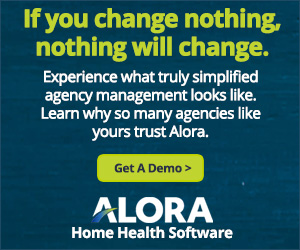
06 Jan Is Your Home Health Agency Staff Ready to Handle Emergencies?
Home health agency emergency readiness for administrators and caregivers
Your home health agency staff should always be prepared for unforeseeable circumstances while delivering home-based health care services, especially outside of medical settings. In such cases, it is necessary to be flexible and resourceful as an emergency may occur, such as a disaster or a sudden illness. Therefore, home caregivers should be well-informed enough to offer the correct response.
The disasters that should be considered include floods, earthquakes, environmental hazards, patients` conditions worsening, or even death, among many others. This helps in appreciating the existing issues and highlights the need for proactive steps that are directed toward fulfilling the responsibility of home health agencies. Preparedness guarantees security and health for the patients, staff, and agencies.
Navigating Emergency Preparedness in Home Health Care
Most homecare managers will agree that quality assurance measures and disaster management protocols should be instituted as routine rules of operation by home health agencies in the event of emergencies. Caregivers and nursing staff within agencies need to understand and obey these rules to fulfill their duties for the benefit of both patients and staff. In this blog, we’ll examine some of the methods that can be implemented to ensure your agency is ready for whatever emergencies arise.
Develop Robust Staff Training Protocols for Emergency Preparedness
Trained staff are critical to ensuring preparedness in an emergency setting. The knowledge and competence of your staff, in terms of preventing or worsening a crisis, will significantly impact the final results. Have you talked to your staff about different types of emergencies and what the agency’s official policies are should one of these occur during patient care in a home, or even at your offices?
The severity of different emergencies differs, therefore, agencies need to be aware of the complexities associated with each situation to develop plans that will help them overcome any hurdles. Adequate preparation for any case of disaster or sudden health deterioration is always a great way to approach emergency management. If your management has not put a plan in place, start from scratch, reviewing different emergency situations, and put policies in writing BEFORE these emergencies happen. This should be a team effort and ideally include drills and occasionally even informal quizzes in much the same way fire drills are conducted in most businesses.
Solidify Your Communication Strategies
Communication is always key within organizations whether large or small regardless of the situation, helping your agency achieve coordination in response to emergencies. Therefore, home health agencies should create distinct communication pathways that could facilitate the sharing of data between employees, patients, and outside parties. It reduces the possible negative consequences by allowing for a systemic reaction in response to any emergency.
Particular attention should be paid to building a culture of emergency communication among the employees during the training. Group sessions and trainings, simulating stressful scenarios through exercises can enhance preparation levels. This provides a practical experience in preparedness for challenges staff may face in emergency reactions.
In addition, it is vital to create feedback systems for improvement. Agencies need to hold debriefing sessions following every emergency training (and of course any real life emergencies) to determine whether there was any improvement in the communication methods used in the disaster. The information obtained in such sessions will help in tailoring protocols and improving the training programs thus creating room for continuous improvement. It is always better to correct mistakes during such drills as soon as possible, so the mistakes do not carry on to real emergencies.
Be Prepared with Essential Equipment and Resources
The management of resources is a key component in the process of emergency preparedness, and through proper resource planning, agencies can maintain business as usual following events of an emergency occurrence. This is essential because let’s be real: regardless of any given circumstance or unfortunate event, you still have to ensure your business is running smoothly and your patient care is on point.
One of the best resources you can use is technology, for instance, Telehealth solutions, mobile phone applications, home health software as the central hub for all operational oversight, and data management solutions all can be utilized to guarantee you are prepped ahead of time. Furthermore, you should have portable disaster relief kits available for caregivers to take into the homes where they are working or at least keep in the trunks of their vehicles. Packets or canned foods, bottles of water, medicines, first aid kits, flashlights, and emergency communication devices can be centralized in a kit for easy access in the event of an earthquake, fire, hurricane, or tornado.
An Emergency Action Plan (EAP) should be available in the event a patient’s health begins declining quickly as a result of an emergency or natural disaster. This can appear either as a table or a chart, residing electronically in a caregiver’s phone if feasible. It is vital that once this is developed, every staff who will interact with patients has been through training pertaining to these protocols, and hence no time shall be wasted on what course of action to take.
Monitoring and Evaluation
Monitoring makes it possible to stay alert and ready for any possible threats and difficulties. This involves tracking the plans of emergency preparedness and making sure that the organization is well-prepared for the time when emergencies occur.
Further, this process helps the agencies assess their efforts in disaster planning. In addition, periodic evaluations allow for checking whether the protocol is effective by analyzing responses and possible weaknesses.
The other component involves defining and monitoring KPIs in relation to emergency preparedness. This means setting standards against which the agencies will assess the impact of their readiness programs. They measure how well staff are able to function effectively with the resources given within any emergent scenario.
What are the challenges & roadblocks?
In an emergency, home health service organizations have issues that will need quick, practical solutions. Let’s examine a few roadblocks that agencies may face in establishing strong effective emergency action plans.
Address Training Gaps for Staff
Training of staff remains one notable obstacle. To address this concern, institute periodic training programs that involve simulations and use online means for frequently updating the staff about the emergency plan your agency has in place. There are many online resources available where such plans are already recommended and laid out in detail depending on the emergency. Check for resources on local websites including fire departments, the department of Homeland Security, and regional government websites for ideas and already established tips and procedures if you don’t know where to start.
Talk to and with your staff
When it comes to emergencies, we previously mentioned the importance of communication at every level of the agency, which due to personalities, time, and other intricacies of running a business, can sometimes be challenging. Open lines of communication where modern technologies are shared and used for timely information updates will simplify the process of implementing and conducting training to improve the preparedness and skills of the staff.
Challenges in Resource Allocation
Resource allocation also has an important role in this overall picture. The solution entails the creation of inventory management systems, identifying the supplies and equipment needed for different types of emergencies, and seeking alternative cost resources to equip staff. The development of a community of collaborations with various agencies on resource sharing, and relationship building should be explored, particularly for agencies operating within rural areas where there can be distance between official state-operated resources.
To meet these challenges, tailor your agency’s preparedness for diverse scenarios. There are many types of emergencies that home health agencies often encounter. Staying ahead of whatever may come should entail:
- Customizing response plans for various systems.
- Conducting routine risk assessments.
- Provide training for staff on how to react to changes in the surroundings.
- Financial Constraints; Stick to your budget
Keep in mind if monetary restrictions complicate the funding of supplies, training, or resources, there are available home health agency grants that will help improve your current budget capabilities.
The Takeaway
Improving emergency preparedness for home healthcare organizations should be characterized as a dynamic process of constant development. Agencies should have better preparedness overall by adequately addressing the pillars of operation readiness, which come down to staff training, effective communication, proper resource allocation, scenario diversity practice, consideration of financial challenges, awareness of regulatory frameworks, technology deployment, engagement with the local communities, and ongoing monitoring. The response in relation to an emergency should not only be focused on resilience and adaptability but the necessity and reliance on home health professionals to save patient lives. Adopting emergency preparedness procedures and putting them into practice well before an emergency occurs empowers home health agencies to approach the future confidently, having been trained and prepared to manage any emergency situation, all the while keeping excellent client care paramount.
Author’s Note: Views, information, and guidance in this resource are intended for information only. We are not rendering legal, financial, accounting, medical, or other professional advice. Alora disclaims any liability to any third party and cannot make any guarantee related to the content.
Additional Home Health Agency blogs:

Alora’s home health software solution is ideal for agencies operating in both skilled and non-skilled care. Training, staff preparedness, cohesion, and workplace protocols are easier to manage and establish with the right technology tools. Building a strong agency culture where caregivers enjoy their work starts with making their job as simple as possible so they can focus on patient care.



No Comments